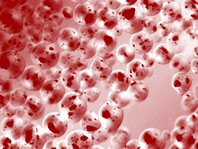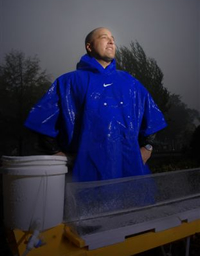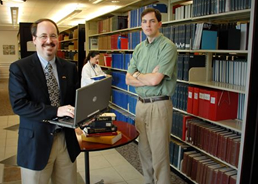UA Start-ups Top Statewide Business Plan Competition
By Chris Bryant, Suzanne Dowling and Deidre Stalnaker Similarities abound between Donald Trump and The University of Alabama’s Dr. William “Bill” Gathings. No, maybe not the hair, but each has demonstrated an entrepreneurial spirit, and both are ardent promoters of a business-based competition with a reality TV show feel. Ok, so with Trump, it’s more than the feel of reality TV. As executive producer and host of NBC’s “The Apprentice,” Trump, the billionaire with the oft-discussed coif, raked in millions of television viewers who tuned in to see who advanced to the competition’s next round. As director of the Office for Technology Transfer at The University of Alabama and a working team member of the Alabama Launchpad business plan competition, Gathings encourages those in the University community to vie for the $175,000 in start-up capital awarded to winners of the state-wide annual business plan competition. “If you are a start-up company, it can be huge,” Gathings says of the $100,000 awarded to the latest Alabama Launchpad winner, Cellulosix. Second place winner, SEA Desalination, also affiliated with UA, won $50,000. “If you can get early stage funding like this, without loss of equity, you build more value in your company,” Gathings said. “Then, when you have to go to the angel investor or venture capitalist, you have increased the value of your company.” Alabama Launchpad is a non-profit organization formed by six of the state’s leading research universities and Alabama’s business community to support entrepreneurship in the state. The Economic Development Partnership of Alabama is also a founding member. Dr. Dan Daly, director of UA’s Alabama Institute for Manufacturing Excellence, known as AIME, serves on Launchpad’s board of directors. AIME and UA’s Office for Technology Transfer collaborate to select commercially promising UA technologies around which teams can be formed and business plans developed for the Launchpad competition. The teams can be made up of faculty, staff and/or student “possibility thinkers,” a term Gathings coined for UA inventors and entrepreneurs. In this, its second season, more than 40 teams participated in the competition for technology and high growth ideas. Eleven of the 12 teams with UA affiliation advanced to the semifinals, five of the eight finalists had UA ties as did both the first and second-prize teams. “Launchpad has been tremendous in that it provides a vetting process for early stage technologies,” Gathings said. The competition’s independent expert evaluation supports and enhances UA’s technology evaluation efforts, he said. Teams which make it past the second of the four-round competition are assigned mentors with business and legal expertise. The mentors can assist in developing and writing business plans and offer additional advice in business operation. “You may have the best technology in the world; it’s your baby, and you think it is the reason a business is going to be successful, but it’s not that simple,” says Gathings, who previously launched two start-ups of his own. “A new technology may launch a business, but a successful venture requires sound management, planning and execution.” In addition to UA, participating universities are Alabama A&M University, Alabama State University, Auburn University, The University of Alabama at Birmingham and the University of Alabama in Huntsville. PLANTS OFFER CONVENIENCE, IMPROVED RESULTS FOR DIABETICS?

The grand prize winning Cellulosix team concentrates on ways to use forms of cellulose – found in the cell walls of trees and other plants – to deliver pharmaceuticals. One goal, for example, is to develop a means for diabetics to take their insulin dosages orally, rather than through injections, says Dr. Richard Swatloski, a licensing associate in UA’s Office for Technology Transfer, who co-leads the team. “The main goal is slow release, or controlled delivery, of an active ingredient,” Swatloski says. For many drugs taken daily, levels in the system initially spike, sometimes resulting in undesired side effects. Medicines entrapped within, or otherwise bonded to, cellulose and swallowed could diffuse gradually, maintaining more constant and effective levels, he says. Why cellulose? “Cellulose is nontoxic and safe to ingest,” Swatloski says. “By encapsulating insulin within cellulose, it is protected from the extreme conditions of the stomach, allowing it to be delivered orally instead of through the traditional injection.” Overall, the team is investigating three specific areas in which cellulose could play a role in treatment and diagnostics: cancer drugs, therapeutic proteins, such as insulin, and in connection with imaging agents. “We will probably pick two compounds in each of those classes for further evaluation,” Swatloski says. As a doctoral student in UA’s College of Arts and Sciences, Swatloski was part of a team recognized with the 2005 Environmental Protection Agency’s Presidential Green Chemistry Challenge Award for its discovery of a new way to dissolve and use cellulose. UA licensed to BASF patented use of the cellulose technologies, and the two entities have a letter of agreement allowing the UA team to move forward with the technology for certain pharmaceutical and nutraceutical benefits. Cellulosix hopes to advance the technology close to the clinical trial level before handing it off to another entity. WATER, WATER NOT EVERYWHERE

Mike Wofsey, a doctoral student in UA’s department of physics and astronomy, leads SEA Desalination Array. His team developed a solar-based technology that removes salt from seawater or removes high mineral concentrations from groundwater. “Our water consumption is doubling every 20 years, but that rate is twice the rate of the growth of the Earth’s population,” Wofsey says. “We have to find a way to make more drinkable water or conserve the water we have.” Wofsey, under the guidance of both a mentor at Lawrence Livermore National Laboratory and UA faculty, began brainstorming an affordable way to convert seawater into drinking water. “Until recently, I had been looking at desalination with electrostatic means. I had a Frankenstein type machine set up with sparks being generated. All through this, the sun’s coming through the window, and I’m ignoring the obvious.” Wofsey realized he needed to simplify to make his product affordable for the user. Under Wofsey’s team’s proposal, the system’s operating cost is 20 cents per thousand liters of water desalinated, one-fifth the operating cost of Tampa Bay’s system, considered one of the world’s most efficient. And construction costs between the two systems are so vast they’re practically incomparable. Wofsey’s system consists primarily of two thermoformed plastic panels – the material in which fresh strawberries are packaged in grocery stores. The unit’s top piece is transparent, and the bottom piece is black. “The intelligence of this is the way the plastic is molded,” says the College of Arts and Sciences doctoral student. “Plastic is a wonderful material because it’s cheap, because the methods to manufacture it exist in developing countries, and because you can make a panel for ten dollars as opposed to a thousand dollars,” Wofsey says. A small solar-driven pump moves the water into the unit, which is self-supporting and contains collection channels, evaporation channels, cooling channels and feed channels. Water fills into e-shaped channels and, through a series of serrations, drips down into other channels, Wofsey says. Heat from the sun causes evaporation and condensation inside the top panel, and the water then drips down into collection channels. This feeds into the back of the unit and flows through the output into the collection container. Left behind in a collection hopper are the salt or other contaminants which can then be emptied from the unit. The unit is expandable. “The more water you need, the more plastic panels you connect,” Wofsey says. “The solar panel drives the pump, and the pump pumps the water right from your well collector or from your sea inlet. Then, gravity and sunlight do the rest.” ProVentix – A PROGRAM OF CARE GIVING This century, millions of sons and daughters will be tested in the care they provide to elderly parents, while employers are progressively more troubled about what has become the number one human resource challenge — eldercare.

Many Americans face a bureaucratic maze of complex decisions involving a long-term care industry that varies greatly by community. That’s where Launchpad finalist ProVentix comes in. ProVentix uses 21st century technologies, the latest information, and expert resources to help imminent and active caregivers and their elderly relatives ready themselves for giving and receiving care. “When a parent suffers a serious health event or the onset of dementia, the family is often overwhelmed by the complexity of the long-term care system, and, unfortunately, the parent is often unable to participate in the decision making process that affects them,” said Dr. Michael Parker, a former UA assistant professor of social work, John A. Hartford Foundation Geriatric Scholar, and executive member of UA’s Center for Mental Health and Aging. “Our company will offer the more than 44 million family caregivers in the United States and their employers access to Web-based tools and resources designed to reduce the financial and health related burdens associated with care giving,” said Parker, who first addressed this problem as an Army officer while completing a National Institute on Aging post doctoral fellowship. Employing a proprietary, patent-pending assessment process for the parent and adult child, ProVentix creates a tailored intervention program that targets the specific circumstances of the caregiver and their parent, and provides the caregiver with access to the most up-to-date information about completing the legal, medical, familial and spiritual tasks of elder care and critical links to local resources in the caregiver’s community. “We are confident that care giving can be consistently delivered in a kind, intelligent manner when caregivers and their parents make an informed entry into their care giving journeys,” said Parker. Parker plans to license the program to organizations hoping to reduce the costs of eldercare to the workplace and develop ‘train the trainer’ programs for human resource and employee assistance personnel, while providing an online service to individual families. SO MANY MEDICAL MATERIALS, SO LITTLE TIME

Most great projects are developed by satisfying a need or solving a problem. Dr. Steven MacCall, associate professor in the UA School of Library and Information Studies, sees a need in medical libraries – there is too much information to sort through in instances where time is critical, especially in the clinical setting where lives may be on the line. With extensive amounts of medical information stored in online databases and on the Web, MacCall, working with colleagues at other institutions, wanted a way to organize it all in a practical manner. “The Web is too big and too complex,” says Dr. Elizabeth Aversa, director of UA’s School of Library and Information Studies. “How do we make it workable for those who need crucial information quickly?” “Librarians are in need of a services platform to integrate selected and collaboratively organized, predictably structured information resources into single points of service, or digital libraries, for their clinical users,” MacCall explains. “There are resources coming in from a lot of places. We are organizing and retrieving in a straightforward manner that works.” MacCall worked with David McMillan, a UA senior programmer analyst, to develop a model for a service platform to integrate and organize a wealth of medical information. They created a template for a digital library, dlservices.net. Using dlservices.net, a physician can access library services he or she needs to diagnose and treat without physically going to a library. The medical facility can integrate electronic patient records creating an online database in the palm of a hand. A physician will be able to look up symptoms, medical history and treatments without leaving the patient. “The library goes to them,” MacCall said. With adequate funding or investments he hopes to find soon, MacCall will develop a scalable prototype. “Practice informed the research, now research is informing the practice,” MacCall said. “We have a model that we have proven to work. We now need to go to implementation on a larger scale.” MacCall sees the possibility for the use of dlservices.net in other fields where there is an abundance of information and heavy reliance on research, such as legal and business areas. UA AND ENTREPRENEURS, A FINE FIT From improving elder care to developing practical methods of sustaining the world’s drinking water supply, issues tackled by participants in the business plan competition are among the toughest faced by society. Glenn Kinstler, director of Alabama Launchpad, lauded UA for its top finishes in the competition. “The University of Alabama should be commended for their hard work in establishing these start-up companies and for providing excellent resources and support for them.” Further Reading